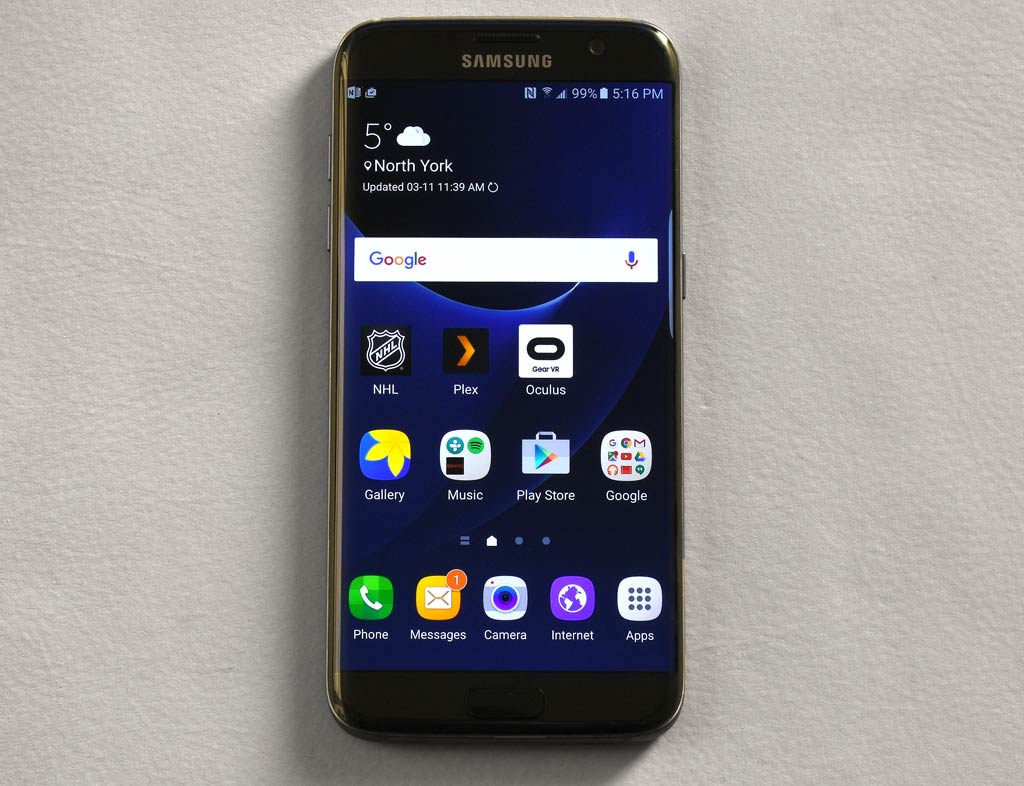
| Samsung Galaxy S7 Edge Display: 5.5-inch 2560 x 1440 Quad HD Super AMOLED edged display with 534 pixels per inch OS: Android 6.0 Marshmallow Processor: 2.6/2.3GHz + 1.5GHz Exynos 8890 64-bit octa-core processor Memory: 4GB RAM, 32GB (microSD card slot expandable up to 200GB) Camera: 12-megapixel rear camera with optical image stabilization, 5-megapixel front-facing Video: Up to 4K Ultra HD video recording Battery: 3600mAh (non-removable) Connections: LTE, Wi-Fi, Bluetooth 4.1, A-GPS, NFC, Fast Charging, Wireless Charging, Samsung Pay (coming soon) Waterproofing: IP68-certification water-resistance Dimensions: 5.94 x 2.86 x 0.77 inches Weight: 157 grams Comes in black |
The Edge is back, this time with a ‘Galaxy S7’ coming before it, showing that Samsung is serious about pushing the notion that an edged display carries advantages. While aesthetically pleasing, the Galaxy S6 Edge and S6 Edge+ were limited in what the edge displays could do. Too limiting, in fact, taking away any real practicality to them. The feature set has been given a boost with the Galaxy S7 Edge, along with a few other returning additions.
The S7 Edge is the larger of the two flagship devices Samsung has launched, with a 5.5-inch Super AMOLED curved screen. It’s slightly lower than the S6 Edge+, yet the S7 Edge’s body is 3mm slimmer, making it a little easier to manage with one hand. I would argue the 0.2-inch screen size discrepancy is going to be negligible for most users.
Design
The other differences aren’t immediately noticeable, either. Though I didn’t have an S6 Edge+ to compare, the only real differentiator, at least upon first glance, would be that it was slightly bigger. The S7 Edge doesn’t stray from the same design principles, otherwise.
It’s still glass front-and-back with metal edges fusing them together. Ports and the speaker are still in the same places, and much of the same functionality has carried over. The power and volume buttons don’t really move, either. The fingerprint reader on the home button, wireless charging (supporting both Qi and PMA standards) and Fast Charging are back.
Three key additions were made to the hardware to offset last year’s omissions. The nano SIM card slot also has a microSD expansion slot, taking the 32GB of internal storage (only 25GB of which is available after system software is accounted for) to new heights. The camera on the back is more flush now, reducing the protrusive bump that irked some users last year. Water resistance, last seen in the Galaxy S5, is now back again. The IP68 rating amounts to about five feet of submersion for up to 30 minutes.
Outside of those things, the camera is a little different, and there have been some tweaks here and there, but the rest of the S7 Edge isn’t a huge leap forward. The screen has the same resolution. The interface, based on a mixture of Samsung’s own TouchWiz and Android 6.0 Marshmallow, doesn’t venture too far into uncharted territory. Some of the gimmicky stuff the company had been known for in the past continues to be restrained in the S7 Edge, though how you might feel about the edge display is another thing.
I should also point out that the S7 Edge is fully compatible with Samsung’s Gear VR virtual reality headset.
Performance and software
Samsung designed both the regular “flat” Galaxy S7 and the S7 Edge to be virtually identical from a performance and software perspective. They each have the same processor, RAM, internal storage, camera and run the same software. Where they differ, of course, is in the edge display, which gives the S7 Edge a secondary interface users can interact with.
When introduced last year, it seemed like the company took a step back after launching the S6 and S6 Edge. The Galaxy Note Edge, though only curved on one side, offered more functionality than the aforementioned duo did. The S6 Edge+, released months after those two, didn’t push the envelope much further.
The S7 Edge expands on those things with more screens to scroll through upon sliding in the interface from either the right or left edge (it’s on the right, by default). AppsEdge is back, doubling app shortcuts to 10. PeopleEdge is the same colour-coded contact shortlist first offered in the S6 and S6 Edge. TasksEdge offers 10 shortcuts to specific functions, like taking a selfie or creating a new contact. This is arguably the most interesting addition to the interface, except I found it too restrictive. For the moment, the list for adding new ones is mainly for basic tasks using Samsung’s apps. There is no third-party app support yet.
This is unlike IFTTT (IF This Than That), an app that strings together apps to trigger an action. TasksEdge is more simplistic, both in that it’s a direct singular shortcut to a specific feature on the phone and that it doesn’t allow for much variation. That doesn’t make it bad, only that it remains unproven. I found some of the shortcuts offered to be as easy to get to through normal navigation away from the edge interface.
The addition of a sports score ticker (courtesy of Yahoo) where I could pick my favourite teams and see the scores in real-time was nice. Tapping one took me to the website with a recap and stats. I found it more convenient for keeping tabs at longer intervals, especially given that other apps can send notifications when your team scores or wins a game.
The news ticker, available from Yahoo or CNN, isn’t bad, and is probably more useful as a means to get to a story. But here, again, there is an alternative already baked in with Flipboard. Swiping right from the home screen reveals it, and is considerably more personalized.
A new software additions is the Always-On display. It shows the time, date, battery level and basic notifications in white text over the black screen when the phone is asleep. The drain on battery life is miniscule, and it floats slowly across the screen so as not to “burn in” to the Super AMOLED screen, which don’t deal well with static images. I grew to like it for simply knowing the time or that a new message came in, though would have appreciated if I could see who it was from before choosing to unlock the phone to check. The notifications are generic, offering no real context as to their origin.
On the hardware side, there has been some speculation over whether the Exynos processor is a downgrade from the Snapdragon one. Truthfully, if you consider yourself a general user, like most people, I doubt you would notice a tangible difference. In fact, I would argue that most users, even tech-savvy ones, aren’t likely to experience a major difference, either.
I had nothing to complain about in that respect. The phone was fluid, fast and responsive and remained consistent throughout my testing.
Camera
The 12-megapixel rear camera represents a different image sensor than that used in all of the Galaxy S6 models last year. Larger micron pixels, coupled with a wider f/1.7 aperture on the lens, mean even more light can pass through than last year’s very commendable effort. The results are significant for the way they make night and low-light photography almost foolproof.
This is a marked contrast. Two years ago, with the Galaxy S5, I would have come away disappointed with a shot in those settings. Last year was a big step forward, whereas the S7 Edge takes another one on top of that by not only making these scenes easy to shoot, but also maintaining a higher level of detail. Personally, I tend to try shooting in the manual Pro mode for greater control over composition, but found that the Auto mode was quite capable under these circumstances. Night and low-light shots in Auto were some of the best I’ve seen in a smartphone to date.
Double-pressing the home button launches the camera right away, even if the phone is asleep, so that remains from last year. It’s one of the quicker-draw cameras available for that reason, where it’s fairly easy to capture a moment quickly. Focusing is also very fast, ensuring you lock onto a subject in short order.
Daytime shooting is interesting because the Super AMOLED display can be slightly deceiving. The screen has more saturated colours and tones, except photos taken during the day, when viewed on a computer, don’t appear that way. They’re more muted, which isn’t a big deal, what with all the photo-editing apps available on Android and PC or Mac, but it is something to note.
Battery life
Despite a slightly smaller form factor, the S7 Edge sports a larger 3600mAh battery (the S6 Edge+ had a 3000mAh one). It’s still not removable, but with more battery packed in, does it last much longer? In some cases, absolutely. In others, it’s less of a gap. This case is helped by Android Marshmallow, which is leaner to begin with, yet also offers battery-saving tools that can stretch things out even further.
I found the S7 Edge comfortably lasted a full day on its own with moderate usage. Streaming hours of video obviously changes that, as would be the case with any smartphone. By and large, the S7 Edge outperforms its predecessors in all aspects of battery life.
Fast charging through the included cable helps top the phone up quickly, and wireless charging is a good alternative.
Final Thoughts
Despite its software shortcomings, this is undeniably the best smartphone design Samsung has brought to market. The processor variants, notwithstanding, the lighter, slimmer and flatter (in the back) S7 Edge is a slick device. With virtually everyone I showed it to concurring, I’m sure I’m on the right track in saying so.
The phone is hardly a reinvention, and the changes are entirely incremental, but they are wisely placed and implemented. The return of memory expansion and water resistance are a big deal to users who hated they were ever cut in the first place. A flusher camera, with improved performance to boot, makes this phone one of the best smartphone shooters out there. Improved battery life only sweetens the pot further.
That said, if the edge display means little or nothing to you, then the regular Galaxy S7 may be a better fit as a more traditional design. It’s essentially the same build with the same specs. The only real difference is the S7 Edge’s curved display and software.
The Samsung Galaxy S7 Edge is available now, and only comes in black.







